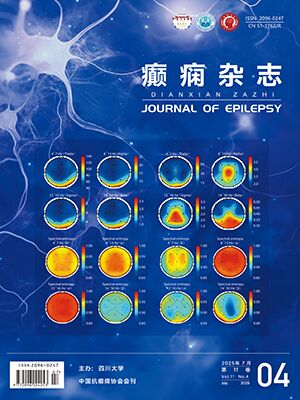| 1. |
Engel J Jr.A proposed diagnostic scheme for people with epileptic seizures and with epilepsy:report of the ILAE Task Force on Classification and Terminology.Epilepsia, 2001, 42(3):796-803.
|
| 2. |
Tenney JR, Glauser TA.The current state of absence epilepsy:can we have your attention.Epilepsy Curr, 2013, 13(7):135-140.
|
| 3. |
Caplan R, Siddarth P, Stahl L, et al.Childhood absence epilepsy:behavioral, cognitive, and linguistic comorbidities.Epilepsia, 2008, 49(10):1838-1846.
|
| 4. |
Berman R, Negishi M, Vestal M, et al.Simultaneous EEG, fMRI, and behavior in typical childhood absence seizures.Epilepsia, 2010, 51(7):2011-2022.
|
| 5. |
Bai X, Vestal M, Berman R, et al.Dynamic time course of typical childhood absence seizures:EEG, behavior, and functional magnetic resonance imaging.J Neurosci, 2010, 30(4):5884-5893.
|
| 6. |
Li Q, Cao W, Liao X, et al.Altered resting state functional network connectivity in children absence epilepsy.J Neurol Sci, 2015, 354(2):79-85.
|
| 7. |
Miao A, Tang L, Xiang J, et al.Dynamic magnetic source imaging of absence seizure initialization and propagation:a magnetoencephalography study.Epilepsy Res, 2014, 108(1):468-480.
|
| 8. |
Le Bihan D.Looking into the functional architecture of the brain with diffusion MRI.Nature Reviews Neuroscience, 2003, 4(2):469-480.
|
| 9. |
Pierpaoli C, Basser PJ.Toward a quantitative assessment of diffusion anisotropy.Magn Reson Med, 1996, 36(5):893-906.
|
| 10. |
Snook L, Paulson LA, Roy D.Diffusion tensor imaging of neurodevelopment in children and young adults.Neuroimage, 2005, 26(3):1164-1173.
|
| 11. |
Rugg-Gunn FJ, Eriksson SH, Symms MR.Diffusion tensor imaging of cryptogenic and acquired partial epilepsies.Brain, 2001, 124(8):627-636.
|
| 12. |
Di Paola M, Di Iulio F, Cherubini A, et al.When, where, and how the corpus callosum changes in MCI and AD:a multimodal MRI study.Neurology, 2010, 74(1):1136-1142.
|
| 13. |
Schulte T, Sullivan EV, Muller-Oehring EM.Corpus callosal microstructural integrity influences interhemispheric processing:a diffusion tensor imaging study.Cereb Cortex, 2005, 15(3):1384-1392.
|
| 14. |
Sykova E.Extrasynaptic volume transmission and diffusion parameters of the extracellular space.Neuroscience, 2004, 129(7):861-876.
|
| 15. |
Luat AF, Chugani HT.Molecular and diffusion tensor imaging of epileptic networks.Epilepsia, 2008, 49(Suppl 3):15-22.
|
| 16. |
Grant PE.Imaging the developing epileptic brain.Epilepsia, 2005, 46(Suppl 7):7-14.
|
| 17. |
Rugg-Gunn FJ, Eriksson SH, Symms MR, et al.Diffusion tensor imaging in refractory epilepsy.Lancet, 20002, 359(6):1748-1751.
|
| 18. |
吕粟.弥散张量成像揭示部分及全面发作癫痫患者的丘脑改变.首都医科大学学报, 2007, 28(6):713-716.
|
| 19. |
Hutchinson E, Pulsipher D, Dabbs K, et al.Children with new-onset epilepsy exhibit diffusion abnormalities in cerebral white matter in the absence of volumetric differences.Epilepsy Res, 2010, 88(4):208-214.
|
| 20. |
Yang T, Guo Z, Luo C, et al.White matter impairment in the basal ganglia-thalamocortical circuit of drug-naive childhood absence epilepsy.Epilepsy Res, 2012, 99(6):267-273.
|
| 21. |
Li Q, Luo C, Yang T, et al.EEG-fMRI study on the interictal and ictal generalized spike-wave discharges in patients with childhood absence epilepsy.Epilepsy Res, 2009, 87(3):160-168.
|
| 22. |
Carney PW, Jackson GD.Insights into the Mechanisms of Absence Seizure Generation Provided by EEG with Functional MRI.Frontiers in Neurology, 2014, 5(4):162.
|
| 23. |
Lopes R, Moeller F, Besson P, et al.Study on the relationships between Intrinsic functional connectivity of the default mode network and transient epileptic activity.Frontiers in Neurology, 2014, 5(1):201.
|
| 24. |
Buckner RL, Andrews-Hanna JR, Schacter DL.The brain's default network:anatomy, function, and relevance to disease.Ann N Y Acad Sci, 2008, 1124(12):31-38.
|
| 25. |
Nolan MA, Redoblado MA, Lah S, et al.Memory function in childhood epilepsy syndromes.J Paediatr Child Health, 2004, 40(4):20-27.
|
| 26. |
Thomason ME, Thompson PM.Diffusion imaging, white matter, and psychopathology.Annu Rev Clin Psychol, 2011, 7(4):83-85.
|
| 27. |
Njiokiktjien C.Differences in vulnerability between the hemispheres in early childhood and adulthood.Fiziol Cheloveka, 2006, 32(5):45-50.
|
| 28. |
Holmes MD, Dodrill CB, Kutsy RL.Is the left cerebral hemisphere more prone to epileptogenesis than the right.Epileptic Disord, 2011, 3(4):137-141.
|
| 29. |
Vinogradova LV.Interhemispheric difference in susceptibility to epileptogenesis:evidence from the audiogenic kindling model in wistar rats.Brain Res, 2010, 1329(11):175-181.
|
| 30. |
Vinogradova LV, Shatskova AB.Lateral asymmetry of early seizure manifestations in experimental generalized epilepsy.Neuroscience, 2012, 213(3):133-143.
|
| 31. |
Keller SS, Ahrens T, Mohammadi S, et al.Microstructural and volumetric abnormalities of the putamen in juvenile myoclonic epilepsy.Epilepsia, 2011, 52(7):1715-1724.
|
| 32. |
Keller SS, Schoene-Bake JC, Gerdes JS.Concomitant fractional anisotropy and volumetric abnormalities in temporal lobe epilepsy:cross-sectional evidence for progressive neurologic injury.PLoS One, 2012, 36(7):e46791.
|




